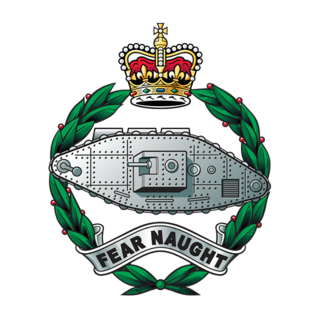
The Royal Tank Regiment (RTR) is the oldest tank unit in the world, being formed by the British Army in 1916 during the First World War. Today, it is the armoured regiment of the British Army's 12th Armoured Infantry Brigade. Formerly known as the Tank Corps and the Royal Tank Corps, it is part of the Royal Armoured Corps.
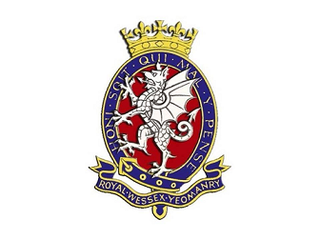
The Royal Wessex Yeomanry is a reserve armoured regiment of the British Army Reserve consisting of five squadrons. Formerly part of 43 (Wessex) Brigade, the regiment joined 3rd (UK) Division in July 2014, to provide armoured resilience to the three armoured regiments within the Reaction Force. In 2015 the regiment was moved from the operational command of 3rd (UK) Division to 1st Armoured Infantry Brigade, and later to 12th Armoured Brigade Combat Team, but members of the regiment still wear the 3rd (UK) Division formation badge to reflect their role in supporting the three armoured regiments in the division.
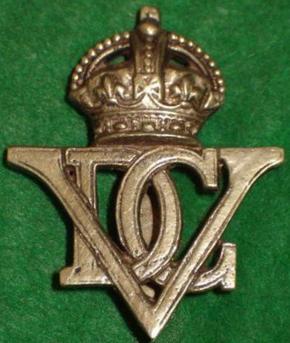
The 5th Royal Inniskilling Dragoon Guards was a cavalry regiment of the British Army formed in 1922 by the amalgamation of the 5th Dragoon Guards and the 6th (Inniskilling) Dragoons. It served in the Second World War and the Korean War. In August 1992, as a consequence of the Options for Change defence cuts, the regiment was amalgamated with the 4th/7th Royal Dragoon Guards to form the Royal Dragoon Guards.

The Royal Canadian Dragoons (RCD) is the senior armoured regiment of the Canadian Army by precedence. It is one of three armoured regiments in the Regular Force and forms part of the Royal Canadian Armoured Corps.
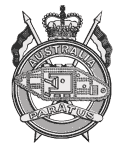
1st Armoured Regiment is an armoured regiment of the Australian Army and is the senior regiment of the Royal Australian Armoured Corps. Formed as a tank unit in the new Australian Regular Army on 7 July 1949, the regiment subsequently saw service during the Vietnam War operating Centurion tanks. Currently the unit is based in Edinburgh, South Australia as part of the 9th Brigade. As part of the Plan Beersheba reorganisation, the unit has become one of three Armoured Cavalry Regiments (ACRs) assigned to the Army's multirole combat brigades in Brisbane, Darwin and Townsville. Each ACR is equipped with M1A1 tanks and ASLAV light armoured vehicles.

The Westminster Dragoons (WDs) was a yeomanry regiment of the British Army Army Reserve, located in central London. Its lineage is continued by one of the Royal Yeomanry's six squadrons. Formed in the aftermath of Second Boer War as part of the County of London Yeomanry, the WDs fought in the Battle of Gallipoli and led British forces onto the beaches during the Normandy Invasion in 1944. The squadron most recently saw action on Operation Telic for which it was mobilised for the 2003 war in Iraq.

The 6th Royal Tank Regiment was a regiment of the Royal Tank Regiment, of the British Army, until 1959. It originally saw action as 6th Battalion Tank Corps in 1917.
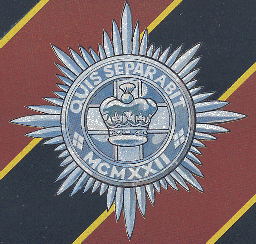
The 4th/7th Royal Dragoon Guards was a cavalry regiment of the British Army formed in 1922. It served in the Second World War. However following the reduction of forces at the end of the Cold War and proposals contained in the Options for Change paper, the regiment was amalgamated with the 5th Royal Inniskilling Dragoon Guards, to form the new Royal Dragoon Guards in 1992.
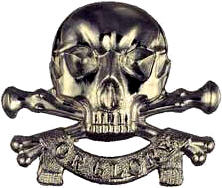
The 17th/21st Lancers was a cavalry regiment of the British Army. It was formed in England by the amalgamation of the 17th Lancers and the 21st Lancers in 1922 and, after service in the Second World War, it amalgamated with the 16th/5th The Queen's Royal Lancers to form the Queen's Royal Lancers in 1993.

The 2nd Royal Tank Regiment was an armoured regiment of the British Army. It was part of the Royal Tank Regiment, itself part of the Royal Armoured Corps and the 1st Mechanized Brigade.

The 1st Royal Tank Regiment was an armoured regiment of the British Army. It is part of the Royal Tank Regiment, itself part of the Royal Armoured Corps and operationally under 12th Armoured Infantry Brigade.

The 3rd Royal Tank Regiment was an armoured regiment of the British Army in existence from 1917 until 1992. It was part of the Royal Tank Regiment, itself part of the Royal Armoured Corps. It originally saw action as C Battalion, Tank Corps in 1917.

The 4th Royal Tank Regiment was an armoured regiment of the British Army from its creation in 1917, during World War I, until 1993. It was part of the Royal Tank Regiment, itself part of the Royal Armoured Corps.
The 45th Royal Tank Regiment was an armoured regiment of the British Territorial Army that fought at the Battle of Alamein during World War II and continued to serve during the 1950s.
49th Royal Tank Regiment, later 49th Armoured Personnel Carrier Regiment and 49th Armoured Carrier Regiment, was a regiment of the British Army's Royal Armoured Corps during World War II that operated specialised armoured fighting vehicles in North West Europe.
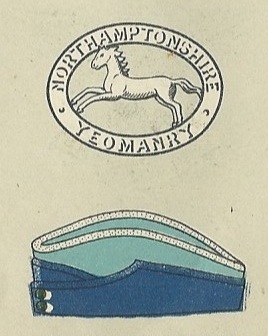
The Northamptonshire Yeomanry was a Yeomanry regiment of the British Army, formed in 1794 as volunteer cavalry. It served in the Second Boer War, the First World War and the Second World War before being reduced to squadron level in 1956. It ceased to have a separate existence in 1971.
General Sir Alan Jolly, was a senior officer of the British Army who served as Quartermaster-General to the Forces from 1966 to 1969.

The 144th Regiment Royal Armoured Corps was an armoured regiment of the British Army. Originally raised during World War II as a battalion of the East Lancashire Regiment it was later transferred to the Royal Armoured Corps. It fought in the campaign in North-West Europe, from June 1944 to May 1945.
The Leeds Rifles was a unit of the 19th century Volunteer Force of the British Army that went on to serve under several different guises in the World Wars of the 20th century. In the First World War, both battalions served as infantry on the Western Front. They were later were converted into an anti-aircraft and tank units, and fought in North Africa, Italy, and Burma during the Second World War.
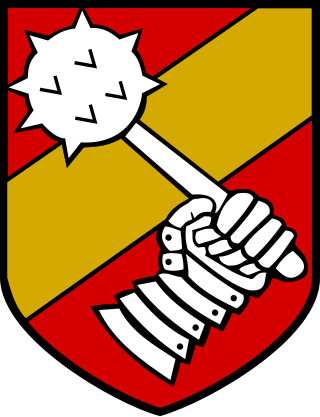
The 34th Armoured Brigade was an armoured brigade of the British Army that saw active service in the Second World War. It was formed in 1941 as the 34th Army Tank Brigade and subsequently redesignated as the 34th Tank Brigade in February 1945 and became part of the 79th Armoured Division. It was equipped with Churchill tanks and provided close support for assaults by the infantry. During the fighting in North-west Europe from July 1944 to May 1945 the brigade served with both the First Canadian Army and the British Second Army. The brigade was disbanded in early 1946.











